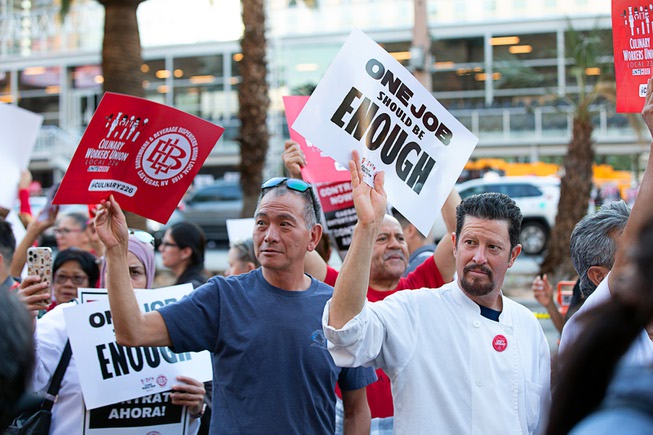
Wen Chang, left, and Alberto Vasquez, members of the Culinary Workers Union, Local 226, picket outside Paris Las Vegas before a Culinary Union civil disobedience protest on the Las Vegas Strip Wednesday, Oct. 25, 2023. The union is currently in contract negotiations with the casinos.
Tuesday, Jan. 23, 2024 | 10:39 a.m.
Unions commanded big headlines last year, but that didn’t translate into higher membership rates, according to government data released Tuesday.
The U.S. Bureau of Labor Statistics said 10% of hourly and salaried workers were members of unions in 2023, or around 14.4 million people. That is an all-time low, down from 10.1% of workers in 2022.
The number of unionized workers in the private sector increased by 191,000 to 7.4 million last year. That includes workers at auto companies, Las Vegas hotels and Hollywood studios, all of whom went through high-profile contract negotiations in 2023.
But the percent of unionized workers in the private sector – 6% -- remained unchanged from the previous year, as unionization rates didn’t keep pace with overall hiring.
The unionization rate for public-sector employees, including government workers, teachers and police, was far higher, at 32.5%. But that sector didn’t see as much growth in employment. About 7 million public-sector workers were union members in 2023, which was unchanged from the year before.
Men had a higher union membership rate last year, at 10.5%. The rate for women was 9.5%. And Black workers have a higher union membership rate, at 11.8%, than white workers, at 9.8%.
U.S. polls show growing enthusiasm for unions. In August, a Gallup poll said 67% of Americans approve of labor unions. That approval has seen a steady rise since 2009, when just 48% of Americans approved of unions, Gallup said.
The National Labor Relations Board reported 2,594 filings for union representation in its 2023 fiscal year, which ended Sept. 30. That was up 3% from 2022, and the highest number of filings since the 2015 fiscal year.
But unionizing a workplace in the U.S. can be a long and arduous process if the employer doesn't support the union. After more that two years, a union drive at Starbucks has expanded to at least 370 U.S. stores, but workers and the company have yet to reach a labor agreement. The U.S. Supreme Court recently agreed to hear an appeal filed by Starbucks in a dispute with the National Labor Relations Board over union organizers Starbucks fired from a store in Memphis, Tennessee.
Union power has also been diluted by “right-to-work” laws in 26 states, which prevent unions from compelling workers to be members as a requirement for their job.
As a result, union membership rates have been on a decades-long decline. In 1983, the first year for which comparable data are available, the U.S. union membership rate was 20.1% and nearly 18 million workers were union members, the Bureau of Labor Statistics said.
